Bulletin – December 2010 Activity in Global Foreign Exchange Markets
According to a recent BIS survey, turnover in foreign exchange markets continued to increase between April 2007 and April 2010. Growth was slower than in earlier years, consistent with a slowdown in the underlying demand for foreign exchange owing to the impact of the global financial crisis on international trade and investment. In an exception to this trend, spot turnover increased significantly, driven in part by the ongoing expansion of high-frequency trading.
Introduction
The foreign exchange market weathered the global financial crisis better than many other financial markets, with turnover increasing by 20 per cent between 2007 and 2010 to US$4 trillion per day. However, the significant impact of the crisis on international trade and cross-border investment flows contributed to growth in foreign exchange turnover slowing from the rapid pace seen prior to 2007, particularly in the foreign exchange swap market. An exception is the continued strong growth in spot turnover, which has been driven by growth in relatively new market segments – such as high-frequency trading – associated with the ongoing development of new technologies. Drawing on the 2010 BIS Triennial Survey of Foreign Exchange and Derivatives Markets, this article explores activity in the global foreign exchange markets over the past three years and discusses the impact of the financial crisis. It then describes some of the key structural changes that have been influential over the past few years and some distinctive features of the Australian foreign exchange market.
Global Turnover
Global foreign exchange turnover grew by 20 per cent over the three years to April 2010 to reach almost US$4 trillion per day (Graph 1, Table 1).[1] This rate of growth was slower than the rapid 72 per cent increase observed over the previous three years and was similar across regions, with no change in the ranking of the major foreign exchange markets. The United Kingdom remains the largest market by location, accounting for over one-third of global turnover in all currencies, followed by the United States and Japan. All three major markets experienced growth of between 20 and 25 per cent over the past three years and their share of global turnover by location increased by 3 percentage points to 61 per cent. Australia remains the seventh largest geographical market, accounting for around 4 per cent of global turnover. The share of cross-border transactions (i.e. where the counterparties are in different jurisdictions) has continued to increase, reaching 65 per cent of global turnover in 2010, up from 62 per cent in 2007.
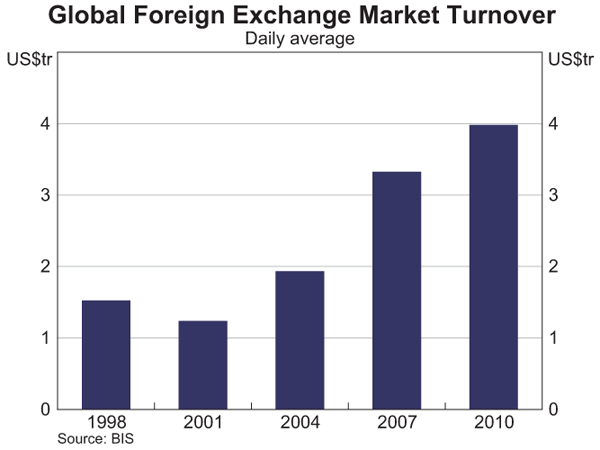
| Change over 2004–2007 Per cent |
Change over 2007–2010 Per cent |
Daily average in April 2010 US$b |
|
|---|---|---|---|
| Total | 72 | 20 | 3,981 |
| Instrument | |||
| Spot | 59 | 48 | 1,490 |
| Outright forwards | 73 | 31 | 475 |
| Foreign exchange swaps | 80 | 3 | 1,765 |
| Cross-currency swaps | 48 | 39 | 43 |
| OTC options | 78 | −2 | 207 |
| Counterparty | |||
| Reporting dealers | 37 | 11 | 1,548 |
| Other financial institutions | 111 | 42 | 1,900 |
| Non-financial institutions | 115 | −10 | 533 |
| Currencies | |||
| USD/EUR | 65 | 24 | 1,101 |
| USD/JPY | 34 | 29 | 568 |
| USD/GBP | 48 | −6 | 360 |
| USD/AUD | 73 | 34 | 249 |
| Other crosses | 104 | 19 | 1,703 |
|
Source: BIS |
|||
Turnover continues to be dominated by the four major currencies. The US dollar makes up one leg in 85 per cent of transactions, the euro is used in close to 40 per cent of transactions and the Japanese yen is used in around 20 per cent of transactions. The British pound is exchanged in around 13 per cent of deals, with the share of turnover conducted in the British pound continuing to fall. The Australian dollar is now the fifth most traded currency, up from sixth in the previous survey, and the share of Australian dollar transactions conducted offshore continued to increase. By currency pair, growth in turnover of the EUR/USD pair eased to 24 per cent, with total turnover in the EUR/USD market accounting for more than one-quarter of global turnover. The AUD/USD cross remains the fourth most traded currency pair.
The pattern of growth across instruments differed from the previous three-year period. Spot turnover increased by 48 per cent over the three years to April 2010, following a 59 per cent increase over the previous three years. In contrast, turnover in foreign exchange swaps increased by only 3 per cent, compared with an 80 per cent rise between 2004 and 2007. As a result, the share of spot transactions in total turnover has increased to 37 per cent from 30 per cent, while the share of turnover accounted for by foreign exchange swaps fell to 44 per cent from 52 per cent (Graph 2). Turnover in the other instruments – forwards, cross-currency swaps, and OTC options – continues to be much lower on average than for spot and foreign exchange swaps.[2]
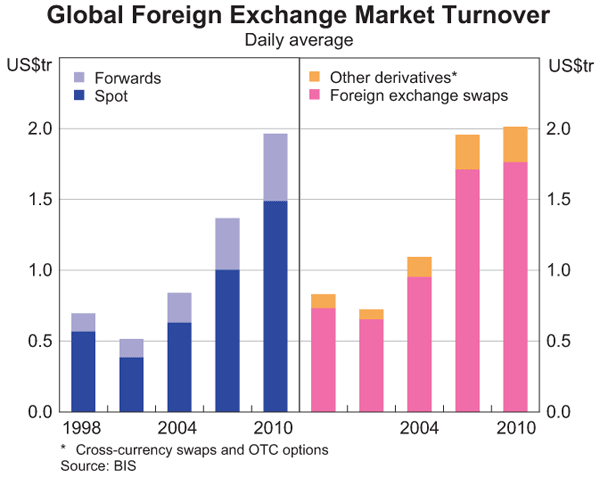
Continuing the trend from previous surveys, growth in turnover was driven by demand from ‘other financial institutions’ such as pension funds and hedge funds, particularly for spot foreign exchange.[3] As a result, for the first time in the history of the survey, turnover between dealers and other financial institutions was higher than turnover within the interdealer market. In contrast, turnover with non-financial institutions fell, driven by a marked decrease in their use of foreign exchange swaps.
Turnover in the foreign exchange market is driven by a range of factors. There is underlying demand from customers for foreign exchange resulting from international trade and cross-border investment. In addition, turnover may be influenced by new technology or changes in the trading behaviour of the market participants. Over the past three years, both economic and structural factors have been at play in driving developments in turnover.
The global financial crisis and its effect on economic activity have contributed to the slower rate of growth in overall turnover than over the previous three years. Global trade is an important driver of spot and forward turnover, especially for non-financial institutions such as importers and exporters, because for most transactions at least one party must exchange its domestic currency for the invoice currency. There is also some additional turnover generated by dealers who manage the risk created by these customer transactions by laying off positions in the interdealer market. Measured over the three years to April 2010 (to match the period of the Triennial Survey), global trade increased by 15 per cent, compared to growth of almost 50 per cent over the previous three years (Graph 3). Slower trade growth is consistent with slower growth in turnover by non-financial institutions, at least partially explaining the 10 per cent fall in turnover between dealers and non-financial customers observed between 2007 and 2010.
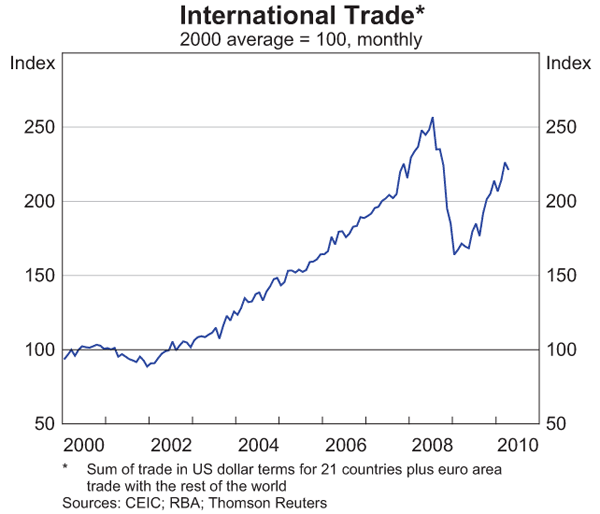
The global financial crisis has also had a significant effect on the willingness of investors to engage in cross-border investment, a second key driver of demand for foreign exchange. Purchases of foreign equities, for example, typically generate demand for foreign exchange as investors convert their domestic currency into foreign currency in order to make their initial purchase. In most cases, investors also hedge a portion of the foreign exchange risk that results from holding assets in a foreign currency. This activity generates ongoing demand for foreign exchange derivatives as hedge positions are set up and then maintained by rolling the hedging instruments over time. In addition, banks use instruments such as foreign exchange swaps and cross-currency swaps to facilitate cross-currency borrowing and lending.
In the first quarter of 2010, the level of international capital flows remained well below that seen in early 2007, around the time of the previous Triennial Survey. The reduction in cross-border capital flows and the lower level of international investment in 2010 relative to 2007 can account for some of the slowing in growth in foreign exchange turnover, particularly turnover of foreign exchange swaps.
Despite the relatively soft growth in economic drivers, turnover in the spot market has continued to grow strongly. This reflects ongoing technological development that has resulted in electronic trading becoming standard in both the customer and interdealer spot markets and has driven growth in alternative market segments such as high-frequency trading and retail foreign exchange.[4] New technology has also changed the way banks manage risks associated with market-making, affecting the distribution of turnover across market participants.
High-frequency trading
Over the past few years the bulk of turnover in the spot market has shifted to electronic platforms. On the whole, these platforms offer immediacy and transparency, as market participants deliver prices continuously to potential clients, who can request execution of trades at those prices in real time via the same platform.
The growth in electronic trading has also enabled high-frequency traders to become increasingly active in the foreign exchange market. High-frequency trading has spread from equity markets, where this type of trading is well established, to take advantage of the large volumes and low transactions costs in the foreign exchange market. These traders employ a broad range of strategies. One type of strategy relies on identifying and exploiting statistical patterns in pricing, of which momentum and correlation strategies are two examples. Another type of strategy takes advantage of pricing differences that may arise for only microseconds, for example, when the price of a currency pair differs very briefly across two platforms. Regardless of the strategy, developing high-speed trade identification and execution technology is key to earning the return, as a delay of even microseconds may mean that the price has moved, eradicating the small expected profit on the trade.[5]
The increasing presence of high-frequency traders in the foreign exchange market has seen spot turnover between dealers and other financial institutions grow rapidly; between 2007 and 2010, spot turnover with other financial institutions almost doubled, overtaking spot turnover between dealers (Graph 4). However, while high-frequency traders have contributed significantly to the growth in turnover, there are no data confirming their share of the foreign exchange market; market reports suggest that high-frequency trading may currently account for between 10 and 25 per cent of turnover. This is a much lower share than in equity markets, where it is estimated that high-frequency trades account for more than one-half of turnover (CFTC and SEC 2010, p 48).
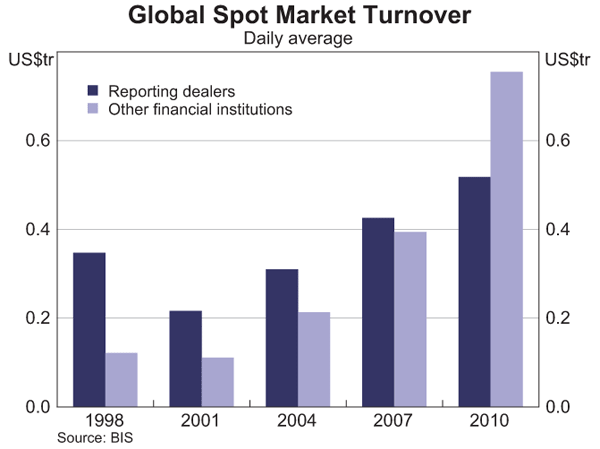
The interdealer market
New technology also continues to generate efficiencies in the way traditional liquidity providers manage the risks associated with market making. Market makers provide liquidity by quoting two-way prices and taking the opposite side of customer transactions, earning a spread but acquiring an open position that exposes the market maker to exchange rate risk. The market maker must either ‘warehouse’ this risk or offset it through trades with other customers or, as is often the case, with another liquidity provider.[6] As a result, an increase in the volume of customer trades has in the past been associated with a roughly proportionate increase in the volume of interdealer trades.
However, over time, the turnover in the interdealer market generated by each customer trade has fallen, mostly because of a process termed ‘internalisation of flow’. New information technology is now enabling larger liquidity providers to manage risk at the institutional level, rather than each trader managing their own position. For those institutions that have sufficient market share, aggregating positions across the institution allows for increased internal position squaring and for better real-time evaluation of the overall risks associated with market making. This reduces the need for the large dealers to manage risk by trading in the interdealer market. The increased efficiency in risk management contributes to slower growth in aggregate turnover and also to a decline in the share of transactions conducted between dealers, especially in the spot and forward markets where the majority of electronic customer trading occurs (Graph 5).

Turnover in Australia
Many of the global trends discussed above have also been at play in the Australian market over the past three years. Growth in aggregate turnover in Australia also slowed relative to the previous three-year period; turnover increased by 12 per cent between April 2007 and April 2010 compared with growth of 60 per cent between April 2004 and April 2007 (Table 2). Growth was driven by spot turnover, which increased by 35 per cent, while growth in turnover of foreign exchange swaps slowed from the previous three years to 10 per cent.
| Change over 2004–2007 Per cent |
Change over 2007–2010 Per cent |
Daily average in April 2010 US$b |
|
|---|---|---|---|
| Total | 60 | 12 | 192 |
| Instrument | |||
| Spot | 25 | 35 | 60 |
| Outright forwards | 123 | −35 | 8 |
| Foreign exchange swaps | 76 | 10 | 118 |
| Cross-currency swaps | 100 | 83 | 4 |
| OTC Options | 24 | −60 | 2 |
| Counterparty | |||
| Reporting dealers | na | 16 | 118 |
| Other financial institutions | na | 10 | 61 |
| Non-financial institutions | na | −6 | 13 |
| Currencies | |||
| USD/EUR | 38 | 60 | 38 |
| USD/JPY | 1 | 39 | 19 |
| USD/GBP | na | 41 | 14 |
| USD/AUD | 66 | −2 | 75 |
| Other crosses(a) | 54 | −1 | 46 |
|
(a) Other crosses includes USD/GBP in 2004 Source: RBA |
|||
Several developments in the Australian market, however, differ from those seen at the global level. The first is that the primary driver of growth was the turnover between dealers, which increased by 16 per cent. Foreign exchange turnover with other financial institutions grew by a relatively modest 10 per cent and, as was the case at the global level, turnover with non-financial institutions fell. Within the non-financial institution segment, the fall is accounted for by lower turnover of both forwards and foreign exchange swaps; spot turnover for this segment increased strongly, in line with continued strong growth in Australian cross-border trade over the same period.
Second, growth in spot turnover was somewhat slower than for the world as a whole, with Australia's share of global spot turnover falling (Graph 6). One potential factor contributing to slower growth is that much of the turnover generated by high-frequency trading is likely to occur in New York or London. This is because the systems executing the trades need to be located close to the electronic systems of market makers to minimise execution delays, in the same way that high-frequency equity trading systems are set up as close as possible to stock exchanges. The strong growth in high-frequency trading is therefore unlikely to be proportionately distributed across existing financial centres.
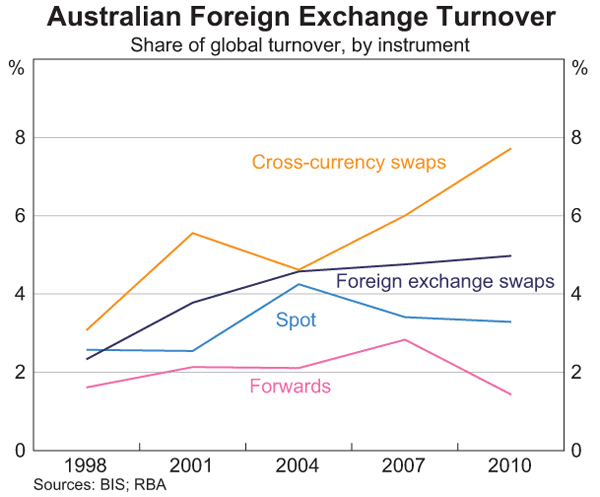
Third, growth in cross-currency swaps was considerably stronger in Australia than at the global level. Turnover in Australia now accounts for around 8 per cent of global turnover in cross-currency swaps, up from around 6 per cent in April 2007, which is considerably higher than its share of turnover for other instruments. Both the level and the trend are related to the use of foreign currency borrowing by Australian banks. When issuing long-term foreign currency debt, Australian financial institutions use cross-currency swaps to exchange the proceeds back into Australian dollars and to hedge the exchange rate risk on their debt repayments. ABS data indicate that Australian banks hedge close to all of their foreign currency debt liabilities using derivatives (as well as over one-half of their foreign currency debt assets).[7] In 2009 and early 2010, Australian banks lengthened the maturity of their balance sheets and issued A$28 billion of bonds, around 60 per cent more than was issued in early 2007. With issuance by banks in the rest of the world remaining subdued, this lifted Australia's share of global bond issuance and by extension Australia's share of cross-currency swap turnover.
The latest BIS data also show that the share of foreign exchange swaps continues to be high in the Australian market compared with that for the world as a whole. There are a number of factors that contribute to this. First, the Australian financial industry has a relatively large pension fund and insurance sector, which uses foreign exchange swaps to hedge the foreign exchange risk on its sizeable overseas asset portfolios. These hedges are typically rebalanced monthly or quarterly. Second, offshore bond issuance by domestic banks can also generate turnover in foreign exchange swaps. Although an Australian bank hedges the foreign exchange risk from foreign currency bond issuance using a cross-currency swap with another bank, this intermediating bank then either squares their position against an offsetting cross-currency swap with another customer (such as an issuer of Kangaroo bonds) or hedges it by using a stream of foreign exchange swaps of shorter maturity. Lastly, the Australian dollar remains a popular currency for carry trades and investors employing this strategy typically roll their open carry positions using foreign exchange swaps.
Summary
Despite the ongoing impact of the global financial crisis on the economic drivers of foreign exchange turnover, the foreign exchange market continued to grow over the past three years. In particular, spot turnover has increased strongly, most likely reflecting the growth of high-frequency trading in foreign exchange markets. Technological advancements have also allowed liquidity providers to continue to improve their risk management practices, reducing the share of trades conducted in the interdealer market.
Footnotes
The authors are from International Department. [*]
These figures are based on current exchange rates. Growth in turnover at constant exchange rates was slightly slower, at 18 per cent. Unless otherwise stated, global turnover figures are adjusted for inter-dealer double-counting at both the local and cross-border level. Australian figures are adjusted for inter-dealer double-counting at the local level only. [1]
Foreign exchange swaps involve an exchange of principal at the start of the contract at the spot rate, and a reverse exchange at the end of the contract at the pre-agreed forward rate. Cross-currency swaps involve an exchange of principal at the beginning and end of the contract at the initial spot rate, and an exchange of interest payments in the borrowed currencies through the life of the swap. [2]
There are three types of counterparty recorded in the BIS Triennial Survey of Foreign Exchange and Derivatives Markets. ‘Reporting dealers’ include commercial and investment banks, securities houses and other entities that are active dealers and report turnover to the survey. Trading between these entities makes up the interdealer market. ‘Other financial institutions‘ include the smaller non-reporting banks and all hedge funds, pension funds and other non-bank financial institutions that are customers of the dealers. ‘Non-financial institutions’ consist mostly of exporters and importers. [3]
Data collected for Australia suggest that the majority of spot transactions are now executed electronically, although the proportion remains lower for other instruments. [4]
High-frequency traders invest vast amounts of capital in building systems that can identify and execute trades within microseconds, so-called low-latency systems. Latency refers to the speed at which one computer program can communicate with another. [5]
This is the traditional definition of a market maker. Today the term is often used to refer to all institutions posting at least a bid or ask price on any electronic platform, regardless of their preference for warehousing any currency risk or providing constant liquidity to the market. [6]
See D’Arcy, Shah Idil and Davis (2009) for more details. [7]
References
D’Arcy P, M Shah Idil and T Davis (2009), ‘Foreign Currency Exposure and Hedging In Australia’, RBA Bulletin, December, pp 1–10.
US Commodity Futures Trading Commission (CFTC) and the US Securities and Exchange Commission (SEC) (2010), ‘Findings Regarding the Market Events of May 6, 2010: Report of the Staffs of the CFTC and SEC to the Joint Advisory Committee on Emerging Regulatory Issues’, September 30.